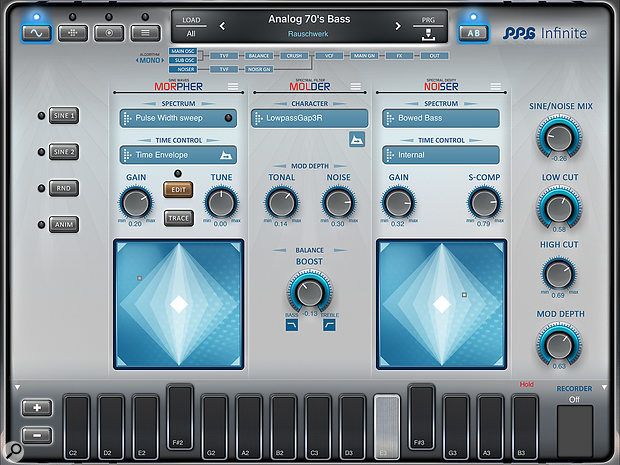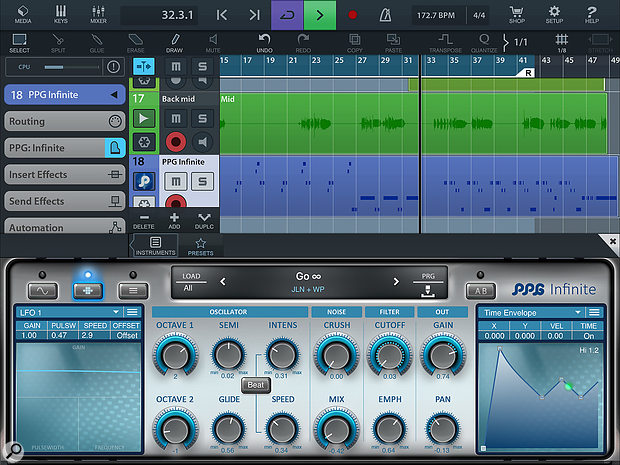 If programming deep synth engines is your thing, PPG Infinite will be just your kind of app.
If programming deep synth engines is your thing, PPG Infinite will be just your kind of app.
Wolfgang Palm is undoubtedly a bit of a synth super-hero to many. He was the man behind wavetable synthesis back in the 1970s but, even some 40 years later, he is still bringing new ideas to the world of synthesizers. This includes iOS music making, and he already has a number of innovative iOS music apps available on the App Store including the brilliant Phonem vocal synthesizer.
His latest offering is PPG Infinite, and this is built on a wavetable-based synthesis engine but includes some innovate new aspects. Key amongst these is that the engine can generate both harmonic and inharmonic sounds (and offers considerable control over both). This should, if you are able to capitalise on the potential of the engine, give you huge sonic scope to explore. Technically, the app can run stand-alone, via Audiobus or IAA and, from launch, as an AU plug-in within a suitable host. A comprehensive MIDI spec is also included and control via an external MIDI keyboard is therefore possible.
Let’s not beat around the bush: Infinite’s infinite sound creation possibilities do come at a price. This is a pretty deep programming experience and, if you are a synth novice, or are just looking for a few presets to bash out some EDM chords, then there are perhaps more appropriate apps you might turn to. However, if you like to get your programming hands dirty, or if your musical tastes lie in the sound design/ambient soundscape (or related) genres, then Infinite is also going to have lots of appeal. Thankfully, there is a PDF manual available to help get you started.
 The app supports the AU format, with the interface adapted to focus on the performance elements rather than the programming options.
The app supports the AU format, with the interface adapted to focus on the performance elements rather than the programming options.
PPG Infinite’s top-level controls are reassuringly organised across four main screens: the Morphing page, the Parameters page, the Settings & Effects page and the Browser page. The latter two are actually pretty straightforward, the bulk of Infinite’s sound design tools being contained within the Morphing and Parameters pages. The Morphing page is where you get access to the Morpher (the primary sound sources where you can blend up to five sounds using the X/Y-style pads), Molder (Infinite’s take on a filter) and Noiser (various options to blend in noise to your sound). This is complex stuff with an almost bewildering array of options.
The Parameters screen includes some almost ‘standard’ synth controls (pitch, pan, volume, etc.) but also some powerful envelope editing options, LFOs and a detailed modulation matrix that allows almost anything to modulate almost anything else. This is a programmer’s playground... although the screens are undoubtedly busy, so, unless you are using one of the larger-format iPads, then make sure you bring your reading glasses.
So much for technical epic-ness, what about the sound? Well, in short, PPG Infinite sounds great. Sonically though, it’s not all ‘epic’, because there are plenty of really quite subtle and delicate sounds amongst the palette of presets. However, there are also some monster leads, a good range of almost ‘special effects’ and a very nice selection of pads. It is the last of these that is perhaps particularly impressive and that show off the nature of the synth engine at its best. If you like your pads to be complex and to evolve, or to cross over into sound design, then Infinite will have you covered.
Given the fairly hefty engine, Infinite is not super-light on CPU resources, but I had no issues on my first-generation iPad Pro and I easily managed a couple of AU instances inside a fairly busy project. Incidentally, the AU version features a more streamlined UI. The intention is that you design sounds in the stand-alone app and then just use the AU version for performance duties within your AU host; it’s a sensible approach.
If deep and powerful synths are the thing that get your musical muse flowing, then PPG Infinite most certainly deserves a spot on your ‘most wanted’ list. At £19.99$19.99, it’s a serious investment (well, in iOS app terms), but I suspect that’s a good thing; the app is deep enough to warrant a bit of commitment in order to grasp how the complex sound-design options can be put to best use.
Like Wolfgang’s Phenom, PPG Infinite is also a bit of a glimpse into the mind of one of the world’s most intriguing synth designers. If you think you are brave enough, then PPG Infinite will, I suspect, reward you with some fabulous sonic surprises.
£19.99
$19.99
